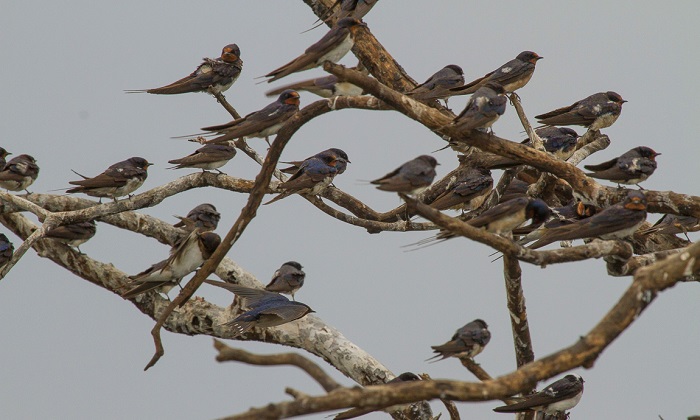Cover image of Barn Swallow by Andries de Vries – Middelburg district, Mpumalanga – BirdPix No. 266068
Identification
The Barn Swallow is a species that is familiar to many. It is conspicuous and in South Africa at least, is not likely to be confused with any other swallow.

Dinokeng, Gauteng
Photo by Philip Nieuwoudt
The sexes are closely alike but males have longer outer rectrices on the tail, and with larger white patches at the tail feather bases. Adults have dark chestnut fore heads with black lores. The crown down to the rump is dark glossy blue. On the underparts, the chin and throat are dark rufous, bordered by a broad blue-black breast band. The remainder of the underparts are white to off-white, often with a pinkish wash in fresh plumage. The flanks occasionally carry some chestnut feathers.

Near Malmesbury, Western Cape
Photo by Gerald Wingate
The tail is glossy blueish-black with oval-shaped white patches on the inner webs of all but the central pair of tail feathers. The outermost pair of rectrices are elongated into streamers. The underwing coverts are white to off-white. The small, slender bill is black. The legs and feet are black and the eyes are dark brown.
Immature birds have paler, buff-grey foreheads and throats. The upper parts are browner and less glossy and the outer rectrices on the tail are shorter.

Kruger National Park, Limpopo
Photo by Lappies Labuschagne
Status and Distribution
Barn Swallows breed throughout the Palaearctic and Nearctic and spend the non-breeding season in South America, Africa and southern Asia. The Barn Swallow is the most widespread swallow species in the world and is found on every continent except Antarctica. The total number of Barn Swallows from western Europe entering Africa every year has been estimated at 22-44 million and possibly twice that many come from eastern Europe and Asia.

Near Ashburton, KwaZulu-Natal
Photo by Malcolm Robinson
The Barn Swallow occurs throughout southern Africa and is an abundant non-breeding Palearctic migrant. The first birds arrive in September, with most appearing in October or early November.
The distribution of the Barn Swallow seems not to have changed in southern Africa but it is undergoing a slow, steady decline in many European countries.

Details for map interpretation can be found here.
In southern Africa, large-scale communal roosting in reedbeds means the Barn Swallow is vulnerable to accidental poisoning due to avicide spraying for the control of queleas and other pest seedeaters. The burning of reedbeds, which is particularly prevalent in dry years, may raise local mortalities. Despite this the Barn Swallow remains abundant, and is not globally threatened.

Kanonberg, Western Cape
Photo by Marius Meiring
Habitat
The Barn Swallow is found over all habitats in southern Africa, particularly in the moister east, favouring open grassland, pastures, cultivation, marshes and open water. The Barn Swallow is most abundant in the higher rainfall eastern half of the subcontinent. It is scarce in semi-arid and desert habitats, but can sometimes be locally common in the eastern Karoo and Kalahari. It is generally uncommon at high altitude, including the Drakensberg.

Isimangaliso Wetland Park, KwaZulu-Natal
Photo by Ryan Tippett
Behaviour
The Barn Swallow is highly gregarious in southern Africa. They roost at night in reedbeds in large flocks numbering in the hundreds or thousands. At some roost sites, flocks are estimated to contain up to 3 million birds. Barn Swallows sometimes also roost in trees or in maize fields. Flocks usually break up into smaller groups and scatter widely by day.

Darvill, KwaZulu-Natal
Photo by Malcolm Robinson
Barn Swallows drink regularly by skimming the surface of still water in flight. They forage aerially at all heights, often in the company of other swallows or swifts. The flight is quick and agile, often swooping low over the ground. They frequently perch low down or sit on the ground during inclement weather.

Carnarvon district, Northern Cape
Photo by Ryan Tippett
Barn Swallows may forage singly, or in loose groups of up to several hundred birds. Prey is captured in aerial pursuit and is less often seized off of vegetation or from the ground.

Witsieshoek Mountain Lodge, Free State
Photo by Mark Stanton
Barn Swallows feed predominantly on small flying insects such as flies, beetles, midges, mosquitoes, moths and wasps etc. They are also fond of ants which they pick from the ground whilst in flight. Similarly, plucks spiders, caterpillars and worms from vegetation. They are also known to feed on the fleshy arils of alien Rooikrans (Acacia cyclops) seeds.
Groups of Barn Swallows are sometimes attracted to grazing cattle, buffaloes or other large animals to feed on disturbed insects. They will also loosely follow vehicles and ploughs for the same reason.

Near Gouritzmond, Western Cape
Photo by Johan Van Rooyen
Before their northward departure in March and April, Barn Swallows gather in their hundreds or thousands. Perching on trees or utility lines, they excitedly ready themselves for their northwards migration where they may travel around 12 000 km in just 34 days or so.

Chobe National Park, Botswana
Photo by Derek Solomon
Further Resources
Species text adapted from the first Southern African Bird Atlas Project (SABAP1), 1997. That text can be found here.
The use of photographs by Andries de Vries, Deon van der Hoven, Derek Solomon, Gerald Wingate, Johan Van Rooyen, Malcolm Robinson, Marius Meiring, Mark Stanton and Philip Nieuwoudt is acknowledged.
Virtual Museum (BirdPix > Search VM > By Scientific or Common Name).
Other common names: European Swallow, Eurasian Swallow (Alt. English); Europese swael (Afrikaans); Mbawulwana (Tswana); iNkoniane (Zulu); Inkonjane (Xhosa); Hirondelle rustique (French); Rauchschwalbe (German); Andorinha-das-chaminés (Portuguese); Boerenzwaluw (Dutch).
List of bird species in this format is available here.
Recommended citation format: Tippett RM 2024. Barn Swallow Hirundo rustica. Biodiversity and Development Institute. Available online at https://thebdi.org/2024/05/16/barn-swallow-hirundo-rustica/

Rietvleidam, Gauteng
Photo by Deon van der Hoven

